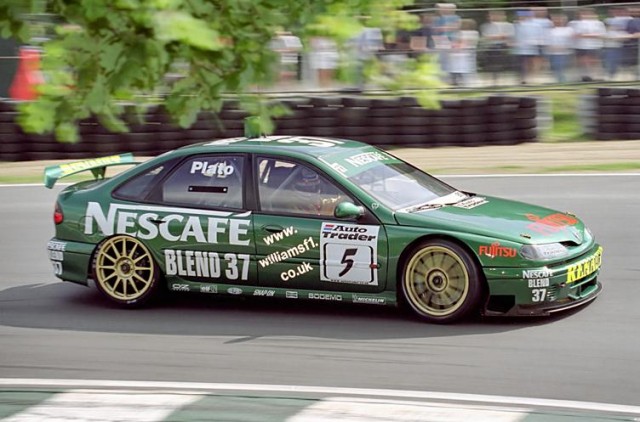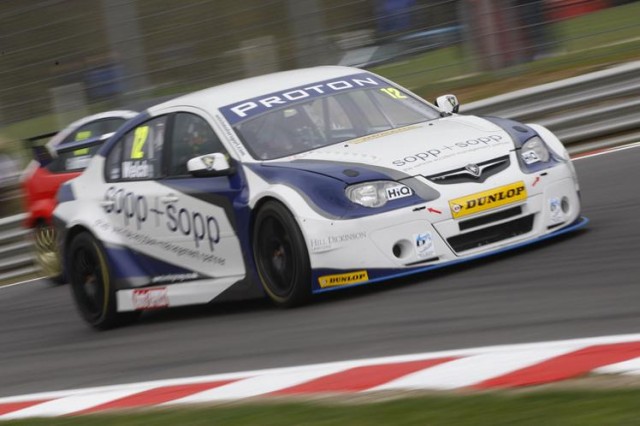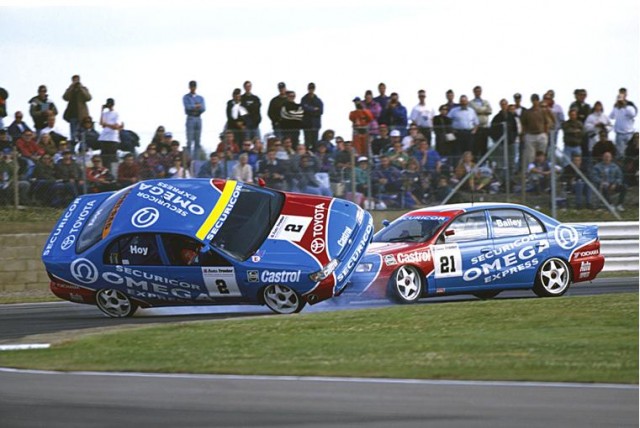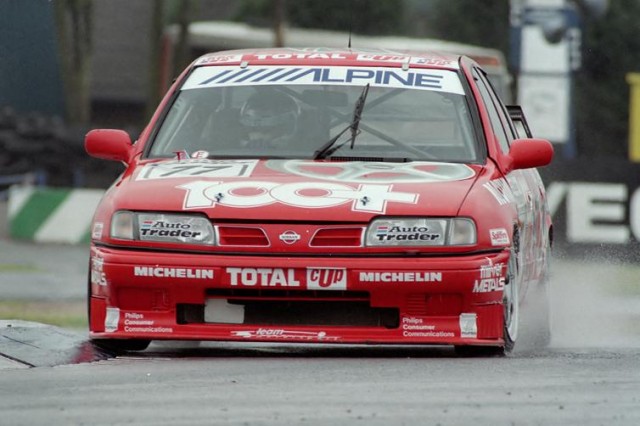It’s a big conversation starter amongst the British Touring Car Championship following, so we look at whether the current NGTC-look BTCC of 2013 can challenge the supremacy of the Supertouring giants of the 90s.
BTCC was very much looking at its best during the 90s. The aggressive-sounding and technically fascinating machines driven by some of the best names of the format offered superb entertainment for 10 glorious seasons before falling through in 2001, arguably the time when the sport was at its ultimate peak by many fans who see it as an era many would return to if just to relive the moment.
But is that a fair analogy? While the road-going saloons have been transformed through technology and engineering over the past decade, the BTCC has always seen great racing and memorable moments each and every season, and 2013 has seen Britain’s favourite tin-top sport head into a personal purple patch thanks to the newest NGTC (Next Generation Touring Car) regulations.
True, the sight and sound of a full grid of cars featuring names such as Alain Menu, John Cleland and Steve Soper dueling it out around Britain’s favourite circuits in almost identical cars fielded by many famous works-backed manufacturers was one that will remain in the memory, but nowadays we see grids of up to 28 cars featuring four BTCC champions and many stars of the future interloping them, still producing racing as exciting, and entertaining crowds continuing to flock in their tens of thousands to watch their heros.
Was it really better back then in the 90s, or is the BTCC’s newest era one to rival it?
The Supertouring days
Following the inclusion of a separate 2 litre class to race alongside the monsters of the BTCC during the 80s such as the Ford Sierra RS500s and Rover Vitesse powerhouses, the BTCC decided that it was time for a change during 1990. A year later, a new era was born – Supertourers.
Designed to showcase an equal form of racing that also gifted manufacturers their opportunity to flaunt their brand, these cars and their drivers produced arguably some of the finest racing in motorsport for the British spectators to enjoy.
Required to be a minimum of 4.20 metres (13.8 ft) in length, the grids of four-door family saloon cars containing no more than a six cylinder, 2 litre engine were an instant hit, attracting the manufacturers and creating many legacies of the sport, from the late Will Hoy in 1991, to Alain Menu who capped the era off with his second title in 2000.
The era saw many classic machines that people will remember possibly more so than today’s machines – from the baffling Volvo 850 estate car of 1994, to the title-winning Vauxhall Cavalier of the following year; from the turquoise BMW 318is of 1992, to the famous yellow and blue Rapid Fit-sponsored Ford Mondeo that wrapped up the 2000 crown.
One of those in the thick of the action during the much-loved mid-nineties era was Patrick Watts, who describes those days as ‘iconic’.
“The nineties were an iconic era, probably never to be repeated. The cars were great bits of kit and the racing was so competitive,” says the former Peugeot favourite.
The Next Generation Touring Car era
Flash forward to today, and NGTC era is already off to a good start; the 2013 season has seen a grid averaging 27 cars take to the circuits as the BTCC has all-but converted to its new regulations down the whole field – barring the exception of Jack Sears Trophy S2000 machines that may not even feature in 2014 due to class entry numbers.
The regulations were created for the 2011 British Touring Car Championship in order to reduce the running costs of the cars and engines and allow more privateer entries to launch an attack, with 300+bhp, 2-litre turbo-charged direct injection engines including fly by wire throttle control and an over-boost function, the TOCA power plant costing around £25,000.
Just like the cars from the 90s, the NGTC machines were designed to produce as level a playing field as possible, with cars all using an Xtrac six-speed sequential gearbox, AP Racing specified brakes and a carbon clutch, essentially all the same base to work on but with a body kit of their own choice and required modifications for rear-wheel drive machines permitted.
Aerodynamics are all specified, with the front incorporating flat floor, apertures for radiator, brake cooling ducts, intercooler and side exits, as well as a specified rear wing profile. Front and rear sub-frames attach to specified points on the car’s roll cage, with the front sub-frame incorporating suspension, brakes, transmission, and engine location.
Although the spec parts have at times been unreliable during their early life, BTCC boss Alan Gow feels the series is as healthy as ever, stating: “The record entry list that we’ve announced today is a great validation of NGTC technical regulations and real testament to the continued success, growth and stability of the Dunlop MSA British Touring Car Championship.
“The current health of the BTCC is absolutely fantastic and even more staggering, perhaps, with the challenging economic climate. Our teams have worked incredibly hard and have demonstrated real commitment to this championship – particularly as the majority have invested in the latest specification NGTC machinery. We continue to evolve this bright new era of the BTCC and all the teams have benefitted from the success of the championship.
The difference in machinery
Ultimately, the Supertouring monsters of the 90s were the quicker, more agile machines thanks to the constant developments necessary for manufacturer bragging rights in the works-inhabited paddock. However, those difference are predominantly subtle, and the BTCC’s newest machines are no slouches.
Take Rickard Rydell‘s Donington pole from the memorable 1998 meeting for example: The Swede clocks in at 1m10.170s, with 2013 pole-sitter Gordon Shedden just 0.090s faster in an NGTC-spec Honda Civic 16 years later.
Another example from 1997 sees Menu (arguably one of the Supertouring era’s greatest BTCC racers from the particular decade) claim a Thruxton pole position of 1m16.538s, which remains just 0.011s slower than Andrew Jordan‘s grid-topping effort from 2013 on a circuit unchanged barring resurfacing in 2000.
In fact, unlike many forms of motorsport including Formula 1, pole position and even race-winning margins still average around the same ball park figures now as they did back in the 90s, pole position advantages lying in the same early 0.2s cushions as they did in 1997.
Bigger pockets not required
Competitiveness has therefore remained similar, but one thing that has improved vastly since the 90s in BTCC is a let-up on the word that most in motorsport dread – costs.
This is a huge card-stealer in a BTCC era game of Top Trumps, the NGTC-specification machines offering a more restrained cost-effective platform to allow for more privateer entrants to get the break they require.
Contrast that to the Supertouring days when the manufacturers all began queuing up to take part as works entries, meaning that teams then had to fork out all the money they could find to produce the finer upgrades to their chassis to make the difference.
Alfa Romeo famously used the rules sneakily to their advantage in 1994 by including a rear spoiler which was permitted due to it being a standard piece of that particular Alfa 155 road model – but as a boot-filling optional extra. A controversial talking point, it eventually saw the use of rear wings and front splitters become mandatory for the following six seasons.
This turned it into a development game which escalated to the point that only three works teams remained in the final year of the era in 2000 – Ford, Honda and Vauxhall – where it is believed that eventual champions Ford spent over £10 million on claiming that crown.
With works teams from the BTC/S2000 era slowly beginning to crawl away such as Vauxhall and SEAT’s manufacturer backing by 2010, the time for change saw the TOCA-supported NGTC regulations attempt to trim costs to an (at the time) estimated figure of £200,000, all in the bid to expand interest, promote Independent squads and offer a close – yet affordable – BTCC experience for all that stepped up.
The drivers
The Supertouring era built up an eviable list of BTCC greats, with champions of Will Hoy, Tim Harvey, Jocaim Winklehock, Gabriele Tarquini, John Cleland, Frank Biela, Alain Menu, Rickard Rydell and Laurent Aiello all names that you now marvel over when looking back.
The decade also ended with the inclusion of the Le Mans genius, Tom Kristensen, not to mention Derek Warwick and Gianni Morbidelli also becoming regulars in the championship post-Formula 1.
That does not even include cameo appearances from Nigel Mansell during the decade; ‘Our Nige’ being in the centre of one of the best BTCC races arguably of all time at Donington during 1998 on a damp day, a place where he also smacked the concrete wall of the bridge exiting Old Hairpin in the 1993 Tourist Trophy.
With the Williams F1 squad also fielding the Renault works team for Menu’s 1997 title-winning campaign, the fame was more nostalgic back in the Supertouring phase, although the 2009 season also saw the name of Johnny Herbert appear on a Dynamics Honda Civic.
Today’s drivers already contains some great names in the field, led by Matt Neal and Jason Plato. The pair hold an astonishing 130 wins from a combined 926 starts between them in the BTCC, Neal having raced in the series since 1991 while Plato started during 1997 – claiming a maiden win at Snetterton when he was Menu’s team-mate in the car of the decade, the Renault Laguna.
Neal became the first Independent to win a race and prove that you could beat the works teams in 1999, those teams having not had the luxury until then of the sticky tyres which made a huge performance difference.
The addition of names like Shedden and Turkington both add to the championship winners list, while young stars such as Andrew Jordan and Sam Tordoff all provide the added splice of excitement for the future of the newest era of BTCC.
The racing
The BTCC has been handed its fame by the cut-and-thrust action it attracts, as drivers try everything to get to the front in what has been very equal machinery with similarly insepeparable driving talent behind the wheel.
The 90s effectively brought the ‘elbows-out’ attitude to the sport, as the boxy Supertourers were no strangers to contact and a helpful nudge as drivers tried to find a way by their opposition to win…sound familiar today?
The similarities are endless, right down to the memorable moments that people remember.
Take 1993’s visit to Silverstone when Julian Bailey’s botched attempt to out-brake his Toyota team-mate Hoy for the lead saw him tip his champion stable mate onto his roof; look ahead 18 years, and we see Neal lunging inside Honda team-mate and friend Shedden at the final corner for the win in race two at Oulton Park, skittering the pair into the gravel.
Take the conclusion to many of these championship fights. A three-way title fight entered the final round last season – one which ended in a wet affair at Brands Hatch similar to the weather that greeted the final race at Silverstone in 2000.
Two team-mates battled for the title there in Menu and Anthony Reid, while Shedden beat team-mate Neal to the title just as Menu pipped Reid in a season-long fight.
The rivalries
…Incidents such as those team-mate fracas often don’t go down well in touring cars, with the BTCC drivers amongst some of the most public for producing WWE-like rivalries during a season – and even career.
Back in the 90s you were never too far away from controversy and the odd tiff between drivers during (and after) a race, but what do you expect when you put such famed names together in the theatre of conflict? Well, in Anthony Reid’s case, you get an earful from Rydell at Brands Hatch in 1998.

Jason Plato and Matt Neal lead the stars of today having claimed their first wins during the late 90s (Photo: btcc.net)
Today’s rivalries are, if anything, more over-publicised than they were in the 1990s, with the most famous rivalry of the previous decade arguably being the one between Neal and Plato.
With five overall BTCC titles between them, the pair have often been magnetised to trouble when they are together on track – starting from a feud at Knockhill during Neal’s 2005 championship-winning season when a clumsy collision saw Plato appear in Neal’s bad book.
Although the pair regard it as just an on-track rivalry, at Rockingham’s infamous 2011 qualifying it came closest of all to providing a genuine bust-up of recent BTCC times – Yvan Muller and Reid’s park ferme confrontation at Brands Hatch in 2003 aside.
While that has boiled over at times, does it match the most famous one from the 90s?
That escalted in the 1992 finale at Silverstone between two of the sport’s greats in Soper and Cleland, one that eventually saw Soper collide with the Scot and end Cleland’s title hopes on the spot, whereupon he would have been glad that the turquoise Vic Lee Racing BMW’s door was jammed shut from the incident as Cleland stalked over with a face like thunder, declaring Soper “an animal”.
Verdict?
We feel that there is an appealing fence here to sit ourselves on for the time being, but it certainly ends with the verdict that the BTCC is in as good a place possible in he current financial climate.
New drivers are seeing their opportunities fall into place to forge out a BTCC future if they can prove their point – look at Aron Smith and Dave Newsham for example – while the famous names such as Plato, Neal, Turkington and James Kaye still remain and still prove the men to beat.
Neal and Plato are drivers to have won top flight races in both eras, the former currently leading the 2013 championship ‘only’ 22 and a half seasons on from his maiden campaign when the Supertouring regulations first began (I hope that doesn’t make you feel too old Matt!)
The big names such as Rouse, Soper, Harvey, Menu, Cleland and so on will make the Supertouring era one of the most nostalgic to turn your opinion towards, but who is to say that we aren’t going through the same now, with Neal and Plato already in that category and with the likes of Shedden, Jordan, Turkington and many new stars to come making the NGTC era its own success.
The 90’s Supertourers ruled the roost back in the past, but while they won’t be forgotten, it already seems the NGTC regulations will keep the BTCC as strong as ever in the present.
BTCC TOP TRUMPS:
Cars: Supertouring – 8 NGTC – 7
Sounds: Supertouring – 9 NGTC – 7
Drivers: Supertouring – 10 NGTC – 8
Fanbase: Supertouring – 8 NGTC – 8
Cost: Supertouring – 3 NGTC – 8
Independents: Supertouring – 5 NGTC – 10
Entertainment: Supertouring – 9 NGTC – 9










